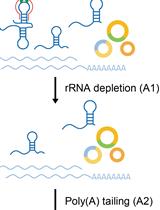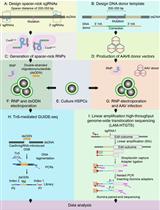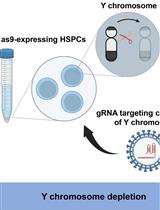- EN - English
- CN - 中文
Minigene Assay to Evaluate CRISPR/Cas9-based Excision of Intronic Mutations that Cause Aberrant Splicing in Human Cells
Minigene技术评估会导致人细胞产生异常剪切的基于CRISPR/Cas9 的内含子突变切除
发布: 2019年06月05日第9卷第11期 DOI: 10.21769/BioProtoc.3251 浏览次数: 6885
评审: Raquel Santana da CruzAnonymous reviewer(s)
Abstract
The construction of Hybrid minigenes provides a robust and simple strategy to study the effects of disease-causing mutations on mRNA splicing when biological material from patient cells is not available. Hybrid minigenes can be used as splicing reporter plasmids allow RNA expression and heterologous splicing reactions between synthetic splicing signals in the vector and endogenous splicing signals in a cloned genomic DNA fragment that contains one or more introns and exons. Minigene-based assay has been used extensively to test the effect of mutations in the splicing of a target sequence. They can also be used to test the ability of CRISPR/Cas9 and one or more associated gRNAs to target specific sequences in the minigene, and determine the effect of these editing events on splicing. As an example, it is shown that CRISPR/Cas9-based, targeted excision of short intronic sequences containing mutations which create cryptic splice signals, can restore normal splicing in a CFTR Hybrid minigene.
Keywords: Cas9/CRISPR (Cas9/CRISPR)Background
Our objective was to use CRISPR/Cas9 to correct the effect on splicing of three different intronic mutations in the CFTR gene which cause cystic fibrosis by creating strong alternative splice sites: c.1679+1634a>g[1811+1.6Kba>g], c.3718-2477c>t[3849+10KBc>t] and c.3140-26a>g[3272-26a>g] (Highsmith et al., 1994; Chillón et al., 1995; Beck et al., 1999) and lead to the disruption of normal CFTR mRNA production.
A CRISPR/Cas9-Non-homologous end joining (NHEJ) approach using two gRNAs has been shown to successfully excise small intronic regions of CFTR gene in > 25% of transfected cells (Hollywood et al., 2016). We hypothesized that this approach could be used to remove the strong alternative splice sites described above with high efficiency in cells with these mutations and restore normal splicing of the CFTR mRNA. The efficiency of the NHEJ targeting approach is at least 10-fold higher than previously reported homology direct repair strategies to correct Cystic fibrosis causing mutations in the CFTR gene.
However, the lack of biological samples carrying these mutations of interest prompted us to ask if it is possible to construct hybrid minigene constructs that contain these mutations as a system to test our reagents, and determine if targeted excision could efficiently restore normal splicing. Once PCR was performed to amplify the wt sequences of interest from genomic DNA, these amplicons were cloned in the exon-trapping pSPL3 plasmid and directed mutagenesis was performed to obtain pSPL3 based minigenes containing the mutations of interest. The pSPL3 plasmid contains a small artificial gene composed of an SV40 promotor and exon-intron-exon sequence with splice donor and acceptor sites and a polyadenylation sequence. A multiple cloning site present in the intron allows cloning sequences of interest, and testing of putative heterologous splicing reactions between the plasmid splice sites and the splice sites contained in the cloned sequences (Sanz et al., 2010).
HEK293T cells were transfected with both wt and mutation containing versions of the three minigenes to characterize by RT-PCR the aberrant splicing caused by these three mutations in the context of the minigenes.
HEK293T were also co-transfected with both the mutant minigene and a plasmid expressing both Cas9 and designed gRNAs. After DNA extraction, PCR across the target sequence was performed to determine the percentage excision caused in mutant minigenes by the CRISPR/Cas9 reagents.
RNA extraction from the same samples allows characterizing by RT-PCR the restoration of splicing due to the excision of the target sequences containing the splicing mutations.
In summary, construction of minigenes allows the analysis of how the sequences of interest are edited using designed CRISPR/Cas9 reagents with specific gRNAs, and how this editing changes the splicing process in the minigene, circumventing the need for primary cells or cell lines with the mutation of interest.
Materials and Reagents
- PCR
- Pipette tips
- 0.2 ml PCR Tubes (SARSTEDT, catalog number: 72.737.002)
- Total Human genomic DNA from Lung (Amsbio, catalog number: HG-601)
- Phusion High-Fidelity DNA Polymerase (Thermo Fisher, catalog number: F530S)
- dNTPs Mix (Thermo Fisher, catalog number: R0192)
- Gel electrophoresis
- TAE buffer (40 mM Tris base, 20 mM Acetic Acid, 1 mM EDTA)
- Agarose (Sigma-Aldrich, catalog number: A9539)
- Ethidium bromide (Sigma-Aldrich, catalog number: E7637)
- 1 kb DNA ladder (Thermo Fisher, catalog number: SM0311)
- 100 bp DNA ladder (Thermo Fisher, catalog number: 15628019)
- DNA Gel Loading Dye (Thermo Fisher, catalog number: R0611)
- Cloning
- 1.5 ml Microtubes (SARSTEDT, catalog number: 72.706.700)
- Petri dishes (SARSTEDT, catalog number: 82.1472.001)
- 15 ml polypropylene tubes (SARSTEDT, catalog number: 62.554.002)
- NEB® 5α competent E. coli (NEB, catalog number: C2987I)
- pSPL3 vector (Thermo Fisher, discontinued)
- pSpCas9(BB)-2A-GFP PX458 (Addgene #48138)
- NheI (Thermo Fisher, catalog number: ER0971)
- XhoI (Thermo Fisher, catalog number: ER0691)
- XbaI (Thermo Fisher, catalog number: ER0681)
- BbsI (Thermo Fisher, catalog number: ER1011)
- T4 DNA ligase (NEB, catalog number: M0202S)
- High Pure PCR Product Purification kit (Sigma-Aldrich, catalog number: 11732668001)
- StrataPrep DNA Gel Extraction kit (Agilent, catalog number: 400766)
- QuikChange II Kit (Agilent, catalog number:200523)
- LB Broth Lennox (Sigma-Aldrich, catalog number: L3022)
- LB Broth with Agar Lennox (Sigma-Aldrich, catalog number: L2897)
- Ampicillin Sodium salt (Sigma-Aldrich, catalog number: A0166)
- Mammalian cell culture
- T75 cell culture flasks (SARSTEDT, catalog number: 83.1813.002)
- 12-well plates (SARSTEDT, catalog number: 83.3921.005)
- HEK293T cells, human embryonic kidney cell line (ATCC®, catalog number: CRL-3216)
- CFTE cells, cystic fibrosis tracheal epithelial cell line (Gruenert et al., 2004)
- Dubelcco’s modified Eagle’s Medium (DMEM, Sigma-Aldrich, catalog number: D5796)
- Minimum Essential Medium Eagle (MEM, Sigma-Aldrich, catalog number: M2279)
- Fetal Bovine Serum (Sigma-Aldrich, catalog number: F7524)
- Phosphate-buffered saline PBS (Sigma-Aldrich, catalog number: P5493)
- Penicillin-Streptomycin (Sigma-Aldrich, catalog number: P433)
- Trypsin-EDTA (Sigma-Aldrich, catalog number: T3924)
- Lipofectamine 2000 (Thermo Fisher, catalog number: 11668027)
- Opti-MEM (Thermo Fisher, catalog number: 31985070)
- Plasmidic DNA and Total DNA extraction
- NucleoSpin Plasmid kit (MACHEREY-NAGEL, catalog number: 740588150)
- DNeasy Blood and Tissue Kit (QIAGEN, catalog number: 69506)
- RNA extraction and RT-PCR
- 0.5 ml PCR Tubes (SARSTEDT, catalog number: 70.704.400)
- NucleoSpin RNA (MACHEREY-NAGEL, catalog number: 740955.150)
- High-Capacity cDNA Reverse Transcription Kit (Thermo Fisher, catalog number: 15561175)
- dNTPs Mix (Thermo Fisher, catalog number: R0192)
- Phusion High-Fidelity DNA polymerase (Thermo Fisher, catalog number: F530S)
Equipment
- Pipettes
- PCR Thermocycler Eppendorf Mastercycler
- Gel Doc System (Bio-Rad)
- Water bath
- Bacterial Incubator and shaker
- Mammalian cell incubator (37 °C, 5% CO2)
- Bunsen Burner
- NanoDrop 2000 spectrophotometer (Thermo Fisher Scientific, model: NanoDropTM 2000)
- Microcentrifuge
- Electrophoresis tank and power pack
- Autoclave
- Biological safety cabinet
Software
- Primer-blast (https://www.ncbi.nlm.nih.gov/tools/primer-blast/)
- CRISPR-Design (http://crispr.mit.edu/)
- SnapGene Viewer (http://www.snapgene.com/products/snapgene_viewer/)
- Tm Calculator (https://www.thermofisher.com)
- Peak Scanner 2 (https://www.thermofisher.com)
- Eurofins (Oligo synthesis, Sanger sequence and Fragment Length Analysis [FLA] service) (https://www.eurofinsgenomics.eu)
Procedure
文章信息
版权信息
© 2019 The Authors; exclusive licensee Bio-protocol LLC.
如何引用
Sanz, D. J. and Harrison, P. T. (2019). Minigene Assay to Evaluate CRISPR/Cas9-based Excision of Intronic Mutations that Cause Aberrant Splicing in Human Cells. Bio-protocol 9(11): e3251. DOI: 10.21769/BioProtoc.3251.
分类
分子生物学 > DNA > 染色体工程
分子生物学 > RNA > RNA 剪接
您对这篇实验方法有问题吗?
在此处发布您的问题,我们将邀请本文作者来回答。同时,我们会将您的问题发布到Bio-protocol Exchange,以便寻求社区成员的帮助。
Share
Bluesky
X
Copy link













